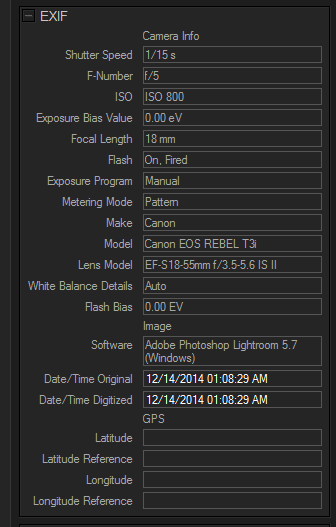- Canon Community
- Discussions & Help
- Camera
- EOS DSLR & Mirrorless Cameras
- Re: Focus Problem on the t3i
- Subscribe to RSS Feed
- Mark Topic as New
- Mark Topic as Read
- Float this Topic for Current User
- Bookmark
- Subscribe
- Mute
- Printer Friendly Page
- Mark as New
- Bookmark
- Subscribe
- Mute
- Subscribe to RSS Feed
- Permalink
- Report Inappropriate Content
12-21-2014 02:58 PM
My t3i is having focusing problems. What can be the cause? Can I fine to the focus like on the fullframe cameras?
Solved! Go to Solution.
- Mark as New
- Bookmark
- Subscribe
- Mute
- Subscribe to RSS Feed
- Permalink
- Report Inappropriate Content
12-22-2014 11:21 AM
@Kolourl3lind wrote:OK I will but I just relized maybe it's because I am zooming after focusing and recomposing?
Yep - most lenses are "varifocal" -- meaning that if you carefully focus on a subject at some specific focal length in the zoom range... then zoom to a new focal length, then your subject will no longer be accurately focus. You must re-focus the lens.
There are a few lenses which are "parfocal" -- mean that if you zoom the focal length after focusing, your subject will still be accurately focused. However... VERY FEW lenses are technically "parfocal" (though some are close).
The lenses that I'm aware of which are "parfocal" are:
- EF 16-135mm f/2.8L USM
- EF 17-40mm f/4L USM
- EF 70-200mm f/2.8L USM (only the non-IS version)
That's it. If you use any other lens, you have to re-focus the lens after zooming.
But I also notice you were shooting at 1/15th sec. That's a bit slow but you were at 18mm (which helps.) Here's the guideline on that.
In the 35mm days, there used to be a general guideline that if the shutter speed is equal to or faster than 1/focal-length (e.g. if shooting at 50mm the you'd want to be at least 1/50th sec.... at 70mm you'd want to be at least 1/70th or faster, etc.) would be adequate. This number doesn't apply to your T3i, but I'll get to that in a moment.
But there are a few caveats with that...
First, It assumes you are actually using very good camera-holding technique and you are actually TRYING to be steady. Good camera-holding technique means you are supporting the camera from below -- typically your left is palm-up supporting the bottom of the camera and lens and your elbow is in toward your chest/stomach. Your body weight is centered between your legs and you have a wide stance. This means you are not leaning so your muscles don't have to work hard to keep you upright and your arms work like a brace to support the camera to your body and of course your body is nicely balanced and stable.
Second, It's just a "guideline" -- not a rule. Some people are noticeably able to be more steady than others (and if caffiene makes you jittery and you just drank a coffee... and all that sort of thing.) And sometimes it takes a bit of practice to learn good technique.
Third, It's also not the same for APS-C size sensor cameras (like your T3i). For that camera, you'd have to multiple the minimum speed by the crop factor of the camera. For a Canon APS-C camera it's 1.6 (but if you wanted to use 1.5 that'd be pretty close.) That means at 50mm instead of using 1/50th you'd actually have to use 1/75th (technically 1/80th if we use the 1.6 factor). e.g. 50 x 1.6 = 80 so for 50mm we'd use 1/80th.
If you have a lens that includes image stabilization, then you may be able to shoot a bit slower.
Most image stabilization claims to improve lens stability by 2 to 4 "stops". What that means it that you can reduce the speed of the shutter... two to four times slower than you'd normally need because the lens is stabilizing for you. But more caveats apply because it's not as simple as "you get 4 stops". The stabilization isn't a guarantee... it's just a liklihood. If it has to be less ambitious to stabilize your shot it will be far more likely to succeed. If it has to be more ambitious to stabilize your shot then it'll do it's best... but there's no guarantee that it will work.
You were shooting at 18mm. So if you are using excellent posture and camera-holding technique but don't have image stabilization and you're the "average" person trying to hold the camera steady, then we multiply 18 x 1.6 and get 28.8. There is no 1/28.8th shuter speed so we'll round that to 1/30th (because there is a 1/30th.
1 stop slower than 1/30th is 1/15th.. and the image stabilization probably is adequate to get you 1 stop slower successfully.
2 stops slower is 1/8th. Image stabilization that claims "4 stops" will usually do well at 2 stops. So this is less of a sure-fire thing, but it does tilt the odds in your favor.
3 stops slower is 1/4 sec. At this point you're pushing the image stabilization system... you'll notice that if you shoot a lot of frames, that the "keeper" rate (good shots you like) will be lower, but you'll see that you are getting some.
4 stops slower is 1/2 sec (based on the base of 1/30th for an 18mm focal length on an APS-C size sensor camera). If you push any image stabilized lens to 4 stops, do not expect to get a very high keeper rate. It'll sometimes help you, but you have to accept that you're really being ambitious in your expectations.
That's image stabilization by the numbers... take the focal length, multiply it by your crop factor (which is always 1.6 but if you want to use 1.5 because it's a bit easier to do that math in our head it's close enough), round up to the nearest shutter speed available. If you have image stabilization you can speed up the shutter speed by 1, 2, 3, or 4 times faster... but each time you get more ambitious your odds of getting "keepers" go down (but it's still better than no image stabilization at all.)
The summary is that your minimum shutter speed (assuming good holding technique and that you are steady, etc. etc.) with image stabilization OFF the 1/30th would be your minimum speed. At 1/15h sec you were relying on 1 stop of image stabilization help. The image stabilization technology in the lens is good enought that "most of the time" it probably will be able to do this (not guaranteed... just likely.) If you were NOT using good posture and holding technique... you may be challenging your image stabilization system to try to keep up.
5D III, 5D IV, 60Da
- Mark as New
- Bookmark
- Subscribe
- Mute
- Subscribe to RSS Feed
- Permalink
- Report Inappropriate Content
12-22-2014 10:33 AM
Flash was manual.
- Mark as New
- Bookmark
- Subscribe
- Mute
- Subscribe to RSS Feed
- Permalink
- Report Inappropriate Content
12-22-2014 11:10 AM
There is not EXIF in your example. You must have stripped it out. But your photo shows several problems. You are seeing them as miss-focus.
I will assume you have the tiny on-board flash? For a shot like this, you need way more light. There are several ways to accomplish this. Are you familar with how to set the camera? Do you have an externa flash? If you could give as much info as you can it will helpful. But the basic cause is insufficient light.
EOS 1DX and 1D Mk IV and less lenses then before!
- Mark as New
- Bookmark
- Subscribe
- Mute
- Subscribe to RSS Feed
- Permalink
- Report Inappropriate Content
12-22-2014 11:20 AM - edited 12-22-2014 11:27 AM
If I remember correctly this was done with my done with my canon 600ex speedlite. I would be shooting low light without it. Also do you know a good program to extra EXIF data so I can copy and paste? I will just have to go back to the raws. But even though that does not explain the bad focus.
OK here we go.
- « Previous
-
- 1
- 2
- Next »
04/16/2024: New firmware updates are available.
RF100-300mm F2.8 L IS USM - Version 1.0.6
RF400mm F2.8 L IS USM - Version 1.0.6
RF600mm F4 L IS USM - Version 1.0.6
RF800mm F5.6 L IS USM - Version 1.0.4
RF1200mm F8 L IS USM - Version 1.0.4
03/27/2024: RF LENS WORLD Launched!
03/26/2024: New firmware updates are available.
EOS 1DX Mark III - Version 1.9.0
03/22/2024: Canon Learning Center | Photographing the Total Solar Eclipse
02/29/2024: New software version 2.1 available for EOS WEBCAM UTILITY PRO
02/01/2024: New firmware version 1.1.0.1 is available for EOS C500 Mark II
12/05/2023: New firmware updates are available.
EOS R6 Mark II - Version 1.3.0
11/13/2023: Community Enhancements Announced
09/26/2023: New firmware version 1.4.0 is available for CN-E45-135mm T 2.4 L F
08/18/2023: Canon EOS R5 C training series is released.
07/31/2023: New firmware updates are available.
06/30/2023: New firmware version 1.0.5.1 is available for EOS-R5 C
- DPP - unable to save edited photos - error message "error 1" is generated in Camera Software
- EOS R7 Menus Do No Match Online Manual in EOS DSLR & Mirrorless Cameras
- Canon R10 newb owner in EOS DSLR & Mirrorless Cameras
- Are the latest Canon mirrorless bodies good at fast and accurate AF? in EOS DSLR & Mirrorless Cameras
- EOS Rebel SL1 vertical lines on display in EOS DSLR & Mirrorless Cameras
Canon U.S.A Inc. All Rights Reserved. Reproduction in whole or part without permission is prohibited.




